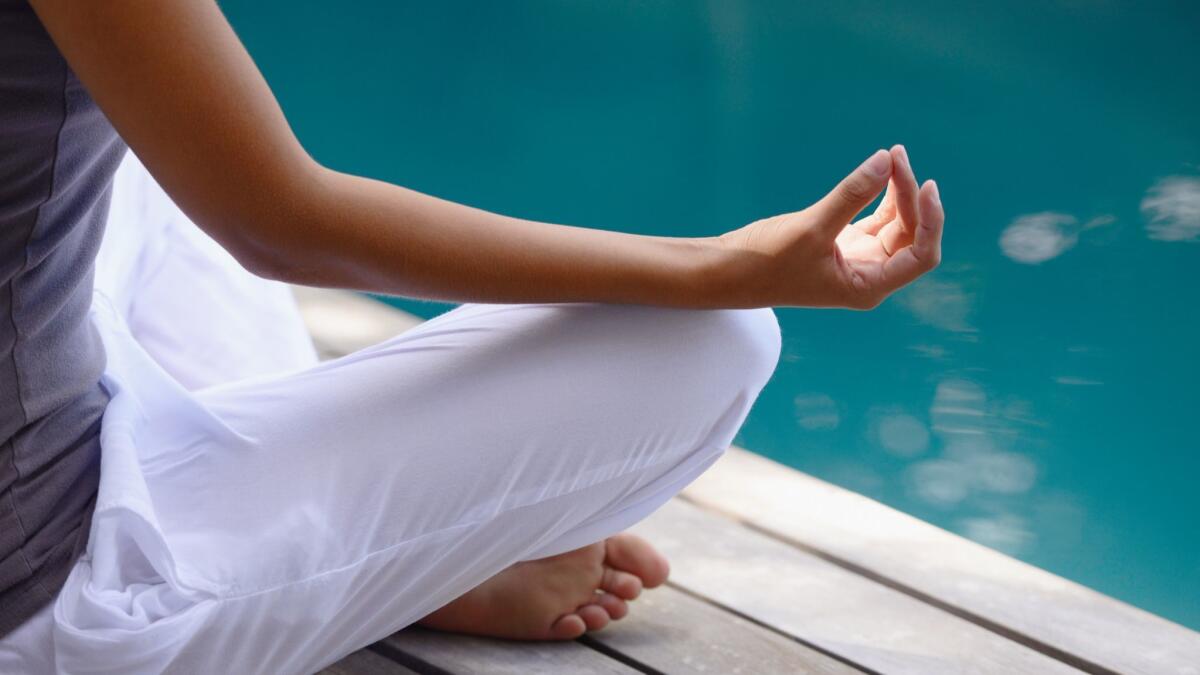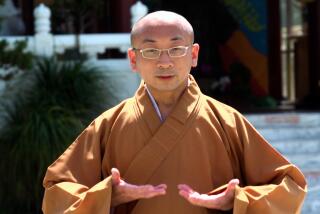A lot more Americans are meditating now than just five years ago
- Share via
If the stress of modern life seems overwhelming, consider giving meditation a try. More than 35 million of your fellow Americans already have.
A new report from the Centers for Disease Control and Prevention says that 14.2% of American adults surveyed in 2017 said they had practiced meditation at least once in the last year. That means it rivals yoga as the most popular type of complementary health practice in the United States.
It’s a dramatic change from 2012, when only 4.1% of adults said they practiced meditation.
And it’s not just grown-ups who have turned to meditation. Over the same five-year period, the proportion of U.S. children who have tried some form of meditation jumped from 0.6% to 5.4%.
The data come from the National Health Interview Survey, a long-running study from the CDC’s National Center for Health Statistics. Each year, thousands of Americans are visited in their homes and asked all sorts of questions about their well-being. Nearly 35,000 adults were surveyed in 2012, as were almost 27,000 adults in 2017. Participants who had children between the ages of 4 and 17 were asked about their kids’ health practices as well.
Overall, the responses show that Americans are becoming more open to health and wellness practices that mainstream medicine still considers “unconventional.” For instance, 14.3% of adults who were questioned in 2017 said they had practiced yoga in the last year, up from 9.5% in 2012. In addition, 10.3% of participants in the 2017 survey said they used a chiropractor in the last year, up from 9.1% five years earlier.
But Americans’ embrace of meditation was far more dramatic. The proportion of adults who at least tried meditation more than tripled over five years, while the proportion of children who meditated at least once increased by a factor of nine.
Among kids, yoga is still more popular than meditation — 8.4% of youths practiced it in the year before the 2017 survey. But among adults, yoga and meditation were in a statistical tie, the report authors said.
The CDC survey considered meditation to be “the act of engaging in mental exercise to reach a heightened level of spiritual awareness or mindfulness.” This could include: transcendental meditation or other forms of mantra meditation; mindfulness meditation, such as Zen Buddhist meditation or mindfulness-based cognitive therapy; and spiritual meditation based on prayer or other contemplative thoughts.
Participants were not asked how often they meditated, only whether they had done so in the last year. Some of those who said yes might have tried it once and decided it was not for them, while others might practice it every day.
Women were more likely to meditate than men, the CDC researchers found. Among adults surveyed in 2017, 16.3% of women said they had practiced meditation in the last year, compared with 11.8% of men. (There was no such gender gap among children, with 6% of girls and 4.9% of boys trying it at least once.)
Meditation was more popular among middle-aged adults than those who were older or younger. The survey found that 15.9% of adults ages 45 to 64 practiced meditation, compared with 13.4% of those in both the 18-to-44 age group and the 65-and-up cohort.
Among kids, the older they were, the more likely they were to meditate. The researchers reported that 4.7% of children between the ages of 4 and 11 had tried some form of meditation in the year before the 2017 survey, along with 6.5% of those ages 12 to 17.
Both Caucasian (15.2%) and African American (13.5%) adults reported higher rates of meditation than Latinos (10.9%), according to the report. There were no statistically significant differences for children based on race or ethnicity.
The National Health Interview Survey did not ask people why they turned to meditation, so the study authors can’t say with certainty what accounts for its recent rise in popularity. But senior author Richard Nahin, the lead epidemiologist for the National Center for Complementary and Integrative Health, suggested some factors that may be at play.

Various forms of meditation are increasingly available at gyms, schools, on television programs and even on smartphone apps, Nahin said. With so many ways to practice meditation, it stands to reason that more Americans would give it a try.
In addition, clinical trials — including some sponsored by the NCCIH — have shown that meditation can improve health by relieving stress and anxiety, improving sleep and generally contributing to a better quality of life, he said. There is even some evidence that meditation can help people reduce their blood pressure and cope with symptoms of menopause.
The growing popularity of meditation creates a virtuous cycle, raising its profile in the culture and prompting more people to check it out, said Richard Davidson, director of the Center for Healthy Minds at the University of Wisconsin-Madison.
When he encounters people who feel too pressed for time to make room for meditation, Davidson advises them to start with as little as one minute a day and stick with it for 30 days straight. “Then, if you find it valuable, you can slowly increase,” he said.
You can learn more about meditation here.
Follow me on Twitter @LATkarenkaplan and “like” Los Angeles Times Science & Health on Facebook.







